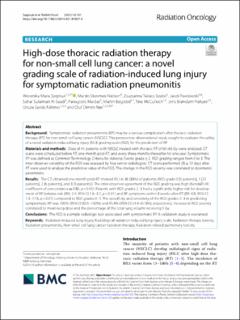| dc.contributor.author | Szejniuk, Weronika Maria | |
| dc.contributor.author | Nielsen, Martin Skovmos | |
| dc.contributor.author | Takács-Szabó, Zsuzsanna | |
| dc.contributor.author | Pawlowski, Jacek | |
| dc.contributor.author | Al-Saadi, Sahar Sulaiman | |
| dc.contributor.author | Maidas, Panagiotis | |
| dc.contributor.author | Bøgsted, Martin | |
| dc.contributor.author | McCulloch, Tine | |
| dc.contributor.author | Frøkjær, Jens Brøndum | |
| dc.contributor.author | Falkmer, Ursula Gerda | |
| dc.contributor.author | Røe, Oluf Dimitri | |
| dc.date.accessioned | 2022-09-27T11:42:23Z | |
| dc.date.available | 2022-09-27T11:42:23Z | |
| dc.date.created | 2021-08-06T16:39:34Z | |
| dc.date.issued | 2021 | |
| dc.identifier.citation | Radiation Oncology. 2021, 16 (1), 1-11. | en_US |
| dc.identifier.issn | 1748-717X | |
| dc.identifier.uri | https://hdl.handle.net/11250/3021766 | |
| dc.description.abstract | Background
Symptomatic radiation pneumonitis (RP) may be a serious complication after thoracic radiation therapy (RT) for non-small cell lung cancer (NSCLC). This prospective observational study sought to evaluate the utility of a novel radiation-induced lung injury (RILI) grading scale (RGS) for the prediction of RP.
Materials and methods
Data of 41 patients with NSCLC treated with thoracic RT of 60–66 Gy were analysed. CT scans were scheduled before RT, one month post-RT, and every three months thereafter for one year. Symptomatic RP was defined as Common Terminology Criteria for Adverse Events grade ≥ 2. RGS grading ranged from 0 to 3. The inter-observer variability of the RGS was assessed by four senior radiologists. CT scans performed 28 ± 10 days after RT were used to analyse the predictive value of the RGS. The change in the RGS severity was correlated to dosimetric parameters.
Results
The CT obtained one month post-RT showed RILI in 36 (88%) of patients (RGS grade 0 [5 patients], 1 [25 patients], 2 [6 patients], and 3 [5 patients]). The inter-observer agreement of the RGS grading was high (Kendall’s W coefficient of concordance = 0.80, p < 0.01). Patients with RGS grades 2–3 had a significantly higher risk for development of RP (relative risk (RR): 2.4, 95% CI 1.6–3.7, p < 0.01) and RP symptoms within 8 weeks after RT (RR: 4.8, 95% CI 1.3–17.6, p < 0.01) compared to RGS grades 0–1. The specificity and sensitivity of the RGS grades 2–3 in predicting symptomatic RP was 100% (95% CI 80.5–100%) and 45.4% (95% CI 24.4–67.8%), respectively. Increase in RGS severity correlated to mean lung dose and the percentage of the total lung volume receiving 5 Gy.
Conclusions
The RGS is a simple radiologic tool associated with symptomatic RP. A validation study is warranted. | en_US |
| dc.language.iso | eng | en_US |
| dc.publisher | BMC | en_US |
| dc.rights | Navngivelse 4.0 Internasjonal | * |
| dc.rights.uri | http://creativecommons.org/licenses/by/4.0/deed.no | * |
| dc.title | High-dose thoracic radiation therapy for non-small cell lung cancer: a novel grading scale of radiation-induced lung injury for symptomatic radiation pneumonitis | en_US |
| dc.title.alternative | High-dose thoracic radiation therapy for non-small cell lung cancer: a novel grading scale of radiation-induced lung injury for symptomatic radiation pneumonitis | en_US |
| dc.type | Peer reviewed | en_US |
| dc.type | Journal article | en_US |
| dc.description.version | publishedVersion | en_US |
| dc.source.pagenumber | 1-11 | en_US |
| dc.source.volume | 16 | en_US |
| dc.source.journal | Radiation Oncology | en_US |
| dc.source.issue | 1 | en_US |
| dc.identifier.doi | 10.1186/s13014-021-01857-8 | |
| dc.identifier.cristin | 1924477 | |
| cristin.ispublished | true | |
| cristin.fulltext | original | |
| cristin.qualitycode | 1 | |

